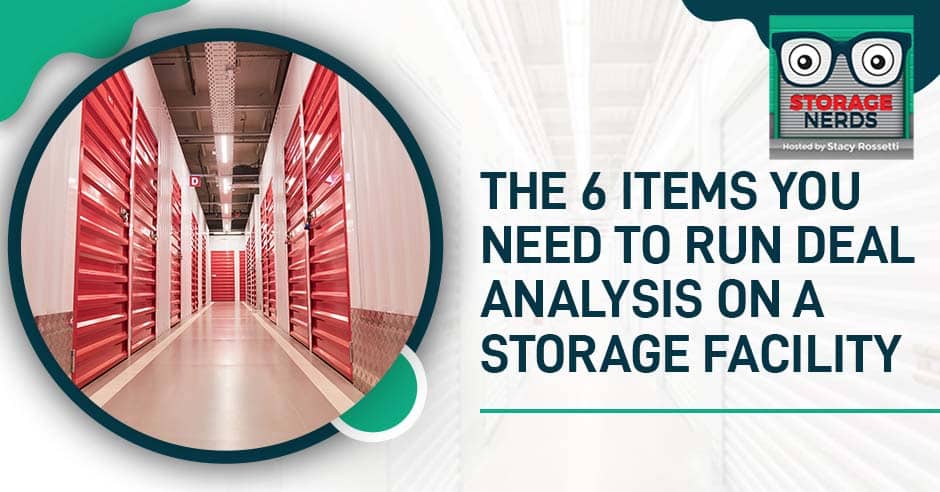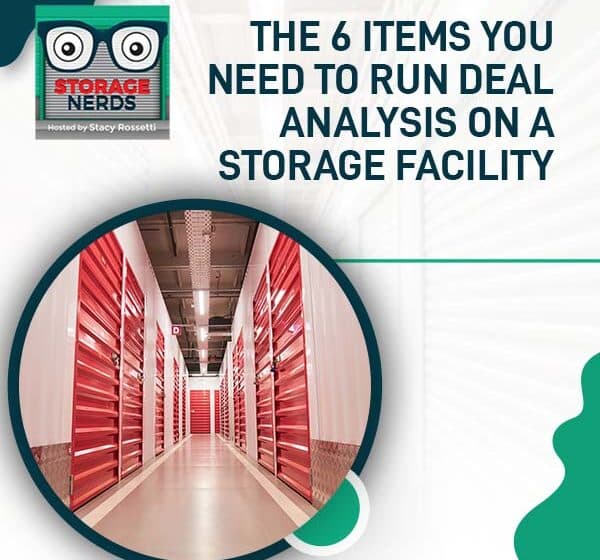
In the world of self-storage investment, making informed decisions is the key to unlocking profitable opportunities. At the heart of this process lies a comprehensive deal analysis that provides the foundation for sound investment strategies. In this captivating episode of our self-storage podcast, we delve into the essential six items you need to run a thorough deal analysis on a self-storage facility. These critical factors will equip you with the knowledge to evaluate potential investments and make confident decisions that align with your financial goals. Be a wise investor and make use of the tools available to you! Today, join Stacy Rossetti as you embark on your self-storage journey.
—
Watch the episode here
Listen to the podcast here
The 6 Items You Need To Run Deal Analysis On A Storage Facility
I wanted to talk about the Deal Analyzer. If you come to the boot camp, you’ll get the Deal Analyzer for free. I sell the Deal Analyzer for $500, but you get that as a bonus for coming to the boot camp. The reason why is that you need the Deal Analyzer in the boot camp. We’re going to go over the deal analyzer. You’ll be able to have hands-on experience on how to use that deal analyzer as well. If you get the course included with it, you’ll get that hands-on experience.

On the Deal Analyzer, I want to make sure that everybody knows with deal analysis what you need to be looking for because a lot of people have this fear of like, “I don’t know if it’s a good deal or not.” You guys are going out and looking at property. You can see all the property on Crexi. You see facilities coming up for sale on LoopNet. Personally, I teach going directly to the owner. That’s one thing that I teach. We do use Crexi in a different way. The cool thing is that we have Crexi and we have a very special relationship. I have Grant who is my coach person at Crexi. He is going to come and do a demo of how we use Crexi in the next couple of episodes.
Make sure you come to the show for that because he’s going to show everybody how to use Crexi not only as a person to buy storage but also as an industry. It’s cool, which is how we do it and I teach this also in the boot camp as well. You’re going out to LoopNet, Crexi, and you’re looking. You’re like, “This price is way too high. I could tell they were too high. The cap rates are too high or too low.” How do I know how to put an offer in on these deals? You never ever want to trust what any realtor or broker says. You want to run your own numbers. We go directly to the owners, the owners also give their information, and we plug it right into the Deal Analyzer. When you’re doing deal analysis on a search facility, there are only a couple of things that you need. Everybody is always like, “I didn’t get the financial, the P&L, the balance sheet, and all this stuff.”
After Updates
The truth of the matter is that you don’t honestly need all that. Now, it’s great to have all that, to look at it, and to see. What you want to do when you run dual analysis is there are three different ways that you look at a storage facility. On the Deal Analyzer, we call it a threat to the current valuation and we go over what we call potential valuation. We do the opportunity. We call this after updates.
It is potential for us because we buy severely mismanaged facilities. Potential for us is taking property from 25% or 50% full to 80% or 90% full. That for us is potential. That potential is physical occupancy versus economic occupancy. Increasing the occupancy and increasing the amount of money that people are paying you. For example, we’re looking at one of our properties, and it’s full. That’s physical occupancy, but we had ten people that were late. We had a whole bunch of a list of partial payments, like people that were behind. It’s what happens during Christmas. I’m going to be honest with you.
For the months of November 2023, Thanksgiving, until now, people either can’t make full payments on their units or they don’t pay it all. During the holidays, what we do internally is we do partial payments. We do a lot of them. We try to help people. I was looking at one of our properties. I was like, “There’s a lot of partial payments here.” We looked at one tenant and they owed maybe $400. Their unit is $125 a month or something. They were behind for a couple of months. You could see there, but from November until now, they were behind. They made a $100 payment in November. They couldn’t make a full amount and then they made $150 and then they’ve just made another $150 payment, which still puts them behind because they are racking up all of the late fees as well too for us.
We don’t take those late fees off. We’re saying, “You’re late. You still have to pay the late fees.” Our late fees equal almost one month of rent. These are a lot of late fees because we try to deter people from not being late. All that adds up. You can see partial payment. Now, it’s like, “It’s the third month. It’s January. We need to get you to pay the full amount. What are we going to do in order to get you to pay the full amount or you’re going to have to go to auction because we can’t keep letting you do partial payments all the time?”
That’s the mismanaged facilities versus economic occupancy. That’s a potential. They were like, “What’s potential?” You have the current valuation, which is the as-is. As of now, what is the value of this property? That’s based on what you’ve made over the last twelve months. When you’re looking at deal analysis, this is how you’re looking at your property. The opportunity is you can add units, expansion opportunities, or you can increase the price.
These are the three ways that you look at the facility from a deal analysis point of view. In our Deal Analyzer, you have three different tabs where you can evaluate your property based on these three types of numbers. That’s step one. I’ll ask my students, “What is the as-is value now and what’s your opportunity? Can you increase the rent? Can you can you do that?”
Competitive Analysis
What do you have to do in order to be able to increase prices? You have to do what’s called a competitive analysis. On our Deal Analyzer, there is a tab where you write in what the competitors are charging for the unit sizes. When you’re looking at a competitor’s price, you want to look apples to apples. If you have in your facility 5 by 10s, 10 by 10s, 10 by 20s, and 10 by 30s, then you’re looking at the competitors and seeing what they’re charging for their units. That is called the competitive analysis. This is a whole part of deal analysis is doing the credit of analysis because you want to know what is the current price per square foot, your potential price per square foot, and your after-updates price per square foot. You see how you are evaluating your property based on those three types of ways of looking at the property.
Unit Mix Analysis
The thing is that you can’t do a competitive analysis unless you know what the unit mix is that the property has. What’s the actual unit mix? Number three is unit mix. You have to get from the owners and broker the actual unit mix, “How many 5 by 5s and 5 by 10s?” You have the size and the price. When you look at prices, you have to look at like, “What price do they have?” The truth of the matter is especially now, there’s not one price. You may find a facility across the board like, “I have a 10 by 10. It’s $50 a month,” and everybody is $50.
You can't do a competitive analysis unless you know the property's unit mix. Share on XBack in the day, when we first started, you saw more and more. There were not a lot of different prices, but now you have your standard price, web price, discounts, and promos. There are all kinds of different prices. You want to make sure that you’re analyzing and you’re getting an average. You’ll look at the website and it’ll say like a 10 by 10 as $100, then you’ll call in and be like, “I’m interested in getting a 10 by 10.” They say, “Great. We’re having a promo now. It’s $20 off. If you sign up now, we’ll give you $80 a month.”
The stuff is all in common. We do this. You can’t just look at a website and then get the price. You need to call and try to figure that out when you’re doing the competitive analysis, but you have to get all the sizes and then what they’re charging and ask them like, “Do you typically add $100 a month for a 10 by 10 or are you doing any discounts now or anything like that?” When you talk to the owners or brokers, they’ll tell you what they’re doing or you’ll get a rent roll.
A lot of times, you’re for a rent roll. If you go to Crexi or LoopNet, then you talk to a broker, most of the time, they’re going to have a rent roll. I would not say always, but definitely 75% of the time they have a rent roll, but there are more facilities I’ve noticed in Crexi. On Crexi, we’ve made offers to every facility. I’ve noticed that there’s a lot of property on there where they don’t even have a rent roll. If they don’t have a rent roll, that’s considered a mismanaged facility.
You want to get the unit sizes. That’s the next thing, and then from the unit sizes, if they’re saying they have a 10 by 10 and 10 by 20s, they got 50 of these and 50 of these. Now you’re like, “This square footage is the total square footage.” If you ask an owner like, “How much square footage are you going to have?” they’re going to be like, “I got 10,000 square feet.” The truth of the matter is based on their unit sizes is what it is. It’s people like a roundabout number and I do this too.
This is how much square footage you have. I’m like, “I don’t like 100,000 or whatever,” because I don’t even know. I honestly have no idea what my total square footage is for any of my facilities at all. I could go into our software and I can look, but if you don’t have software, you have no idea. You have to get all the exact unit sizes and add that up to get the total square footage because total square footage is super duper important. In this storage world, people don’t say, “I’ve got 10,000 square feet.” When you’re running your deal analysis, you’re looking at price per square foot. The only way you’re going to get the price per square foot is from your unit sizes and competitors.
You’re looking at your unit sizes, and then you’re looking at what the owners and competitors are charging because your ultimate goal is this after updates. Your goal in knowing deal analysis is knowing what the opportunity of this property is, “Can I increase rates? Can I expand the property?” We can only figure that out as you look at your competitive analysis and unit mix size so that you can figure out what your price per square foot is for it, potential, and after updates. You can only figure out, which is the most important part and what I’m telling you now, through deal analysis. What is your price per square foot for these three types of evaluations? The only way you can figure that out is if you do that.
For everybody who’s ever sent me an email and said, “Is this a good deal?” nobody can know that unless I know this. The only way you can know this is through competitive analysis and unit mix analysis. Now that we got to that, then we go back to potential, physical, and economic occupancy. This is what I talked about. You may be looking at it as a mismanaged facility or an income-producing property. Is it 80% full or is it 80% less? If it’s typically less than 80%, if you consider mismanaged, 70% to 80% may be a gray zone, but it’s mismanaged if it’s not at 80% occupied or more. What is the price per square foot that they’re charging now and what’s the possibility? Are they where they’re at?
We put at least 5 to 10 offers in a week on properties and rarely ever in the thousands of offers that we’ve put in the last couple of years, maybe a handful of 10 or 20, have their price square foot equal to what it should be on the market value. They’re always way lower. There’s always a potential to be able to increase that price per square foot. Your physical and economic occupancy rarely ever do I see like that matching up as well too. There are always units available, partial payments, or delinquencies. This is a huge and big part of deal analysis.
You have to be able to look at both of those in order to figure out what you’re going to offer. Notice that all of this right here, I have not purchased price in. The only way you figure out what your purchase price is is if you know all of these things. Somebody’s going to tell you, “I want to sell this thing for $1 million.” It’s like, “I don’t give a crap you want to sell it. Tell me about these issues. Tell me these parameters so that I can figure out what the value of your property is.” Don’t ever be scared by what somebody wants for a property.
Do your own due diligence and analysis and put in an offer that fits your parameters or the parameters of the eal analysis. There are many many times we put the offer in and we’re like, “We want to create a win-win situation, but the truth is what you want is not achievable. This is nice because I went through this entire process. Tell me what I’m doing wrong here, and then we’ll change it up.” It’s an educational thing for the owners. A lot of times, unless you use a big realtor if you’re using Marcus & Millichap or something like this, they have internal deal analysis, but if this person is listing it on Crexi and they went got their cousin to list it for them, ignore the price and put your own offering.
Financial Inputs
Next is potential versus physical occupancy. It’s super important. What else is there? The next thing that you have to know in order to run the deal analysis is financial inputs. You have to know how you’re going to pay for this property. You have to know the numbers and the inputs of where you’re going to get the money from. If you do not know where you’re going to get the money from, the parameters, and terms of that institution or person, or whatever it is, then you cannot run deal analysis.
You can’t just put an offer and hope that you find the money for the numbers. What does that mean? If you want to run a deal analysis, you need to know what your terms are going to be. If you can’t afford so much, you need to find a bank that will be able to lend. What are the terms of those banks? You can run a deal analysis. We have cash and bank financing on our deal analysis, and then we have private money lender financing, seller financing, or other creative structures. If you want to get the deal financed, you need to be talking to these people in order to know what the terms are so you can plug the terms in.
Purchase Price
If you go to a local bank versus a nationwide bank, your terms are going to be totally different, or even a hard money lender. You have to be able to plug those numbers in so you can run the numbers based on all the other inputs that we’re putting in. If you’re going to get a private lender like debt or if you’re going to do a partnership, then you need to be able to plug those numbers whatever the terms are going to be so that you can run the numbers. Financing inputs are a huge part of it. The financing inputs include what your cash-on-cash is, what your ROI is, and what your mortgage payment is going to be.
In order to figure all this out, you have to have the terms. After you do the financing inputs, you can come up with your purchase price. Don’t worry about the purchase price. You have all this information inside the deal analysis. What’s important is what we call the market cap rate. Every market is different. I’ve taught this over and over again, but you’ve got primary. Look over this in-depth in the boot camp. It’s also inside the course if you want to do the course. Primary, secondary, and tertiary.
Depending on where the location of the property is is based on what your cap rate is. Once you figure out your cap rate, then you can do your different valuations. That’s important, primary, secondary, and tertiary. A market cap rate is important when it comes to financing. If you’re going to get bank financing, your cap rate is going to be different than if you’re going to get seller financing.
Commercial Deal Analysis
It’s important to do that, but that’s all explained and none of the deal analysis, and we will talk about that also in the boot camp as well. I wanted to give you an idea of how the deal analysis works overall and how are you looking at the property. These are all the things that we input into our Deal Analyzer so that we can look at the overall picture. Hopefully, you guys are doing the same thing as well and learning how to do this commercial deal analysis. Storage facilities are classified as industrial warehouses and that’s how it is. It’s price per square foot, “Where am I at right now? Where can I get it?” Ultimately, you figure that out and then you can come up with your price.
I saw a couple of questions. I’m going to answer those before the time is up, “I’d like to attend your boot camp. I already have your course.” If you bought the course over the holidays, I highly recommend you go through the course and then come to the boot camp. With both of those, I’m going to tell you for 2024, you’d be rocking and rolling because that’s going to give you the boost to be able to get out there and look for the facilities. I highly recommend that. Go to StacyRossetti.com, click on Bootcamp, and then you can sign up for that as well. It’s on the 27th and the 28th.
“If you were to live your life again and become a self-storage newbie, would you begin your journey exactly the way you did or you start with a larger facility?” I would not change a thing about what I did. My personality is slow and steady wins the race. Me and Pete, this is our personality and this is how Lillian is, my daughter. I know it seems like I do a lot and I’m super fast in everything I do, but we’ve been investing in real estate since 2010. This is many years in the making.

My daughter and I were watching Facebook and this video came on. It was a reel. There was a girl who was in her twenties. She had one of the very first drawings that she did. It said like, “Six years ago, this is how I used to draw.” She ripped the page in half and started drawing the other half of this face that she had. It was amazing. She was drawing the most beautiful artwork and then she took off the page and she was like, “You can see I’m the old face and then the new face.” It was amazing. The truth is that’s how me and Pete are.
Many years ago, we didn’t have any idea what we were doing. We bought one facility in our first year and one facility in our second year, and then it started to click for us. It started to get good and we start buying a lot of storage facilities. I make it seem like it’s super easy, but the truth is slow and steady wins the race. I say this all the time. There is nothing wrong with buying smaller facilities. It doesn’t matter if you’re going to afford a couple hundred thousand dollars or a couple million dollars. Buy what you can afford and get your foot into the door.
I have a student, Rick. He’s a CPA who works 60 hours a week. He wants to not work 60 hours a week. He got into the coaching program. He makes a lot of money, but he works his butt off. He was like, “I want to get in the storage. I wanted to be passive,” and I said, “You got to buy a $2 million plan at $1.5 million or $2 million-plus properties so that you can hand this property off to a third-party management company and they can manage it for you.” He got into the coaching program. Within a month, he had a storage facility under contract. He closed on it on the second of January and he’s been in the program now. It’s a long time to close the facility. It took five months.
He finally closed on the facility. He hired a third-party management company to manage it. He’s like, “I’m ready to buy the next one. I can close another one.” There are people who are like that, and then there are people like Linda. She’s another student of ours. She picked up a facility in Texas that was 10,000 square feet for $250,000 or $300,000. She got it at a great price. She got the owner to seller-finance it. Within 60 days, she closed on the property. It’s a little tiny facility in a small town in the middle of nowhere. This is her facility to get her feet wet, to figure it out and stuff.
She’s doing an amazing job and is super coachable. There are people like that. Whatever is the best fit for you is what you should be doing. There’s no right or wrong answer to getting into this industry. Have I heard of Star Trek? No, I haven’t. I have no idea. I’ll check it out. I don’t know anything about Star Trek. The potential is for mismanaged facilities. It’s taking a facility from 25% to 80% or 90%, “What is the potential of the property? How can I get this thing full?” Leslie is asking, “What is the average price per square foot to expand this?” I have no idea because every place is different. Get a whole bunch of quotes. It still goes up and down. It’s very variable. I can’t just give you a number. We can do a deal analysis on it.
Whatever is the best fit for you is what you should be doing. There's no right or wrong answer to getting into this storage industry. Share on X“Is there a resource that shows the cap rate of a specific market?” There’s not. That’s another thing. With Crexi, you can look at like what the sole properties are going for, but there’s not. The truth is that you need to try to do as high of a cap rate. I talked to a student like, “I’m sitting at a 10% cap rate.” I’m like, “You never going to get a deal. You went 10% cap rate. You’re never going to buy a deal.” We try to stick to a 7% or 8% cap rate. That’s a good number for us, whether it’s primary secondary tertiary. People want steals of a deal. The truth of the matter is there is no steal of a deal anymore. That’s gone. You guys are past that. You should’ve gotten into storage many years ago. All my properties in the first twelve facilities I bought is the steal of a deal, but now, you have to be reasonable like all the other properties out there.

Lee says she wants to invest. You should invest. Lending is one of the best ways to get into self-storage. I have all these funds and all these people put all this money into all these funds, and then they sit there and watch me do all the work. They get to learn how to do it. They get a paycheck every month. Lending is the best way. We are starting to lend out as well at wanting to funds and stuff like this. Ultimately, our goal is going to be to invest in other people’s properties. TurnKey Acquisitions for us in StorageNerds is the first step for me for that. I partner with my students. That’s something I want to do more. That’s the same concept. Investing in other people’s deals is a great way to do it.
The bigger the facility, the more money. And it takes the same amount of work for all the facilities. Share on X“With respect to the facility size, do you think that the facility size between 40 and 60 would be a good start to a first facility?” Yes. That would be a great start, affordable property. It is a great way to get started, definitely for sure. Whatever you can afford is the perfect size, if it’s $10,000, $20,000, $50,000, or $100,000. The bigger the facility, the more money you make. It takes the same amount of work for all the facilities. Get started. We started 50 units and now we’re buying 500 units. We build 1,000 units. I appreciate it. Time is up. I have to move on, but I will see you up the next episode, and hopefully at the boot camp as well. Take care.


